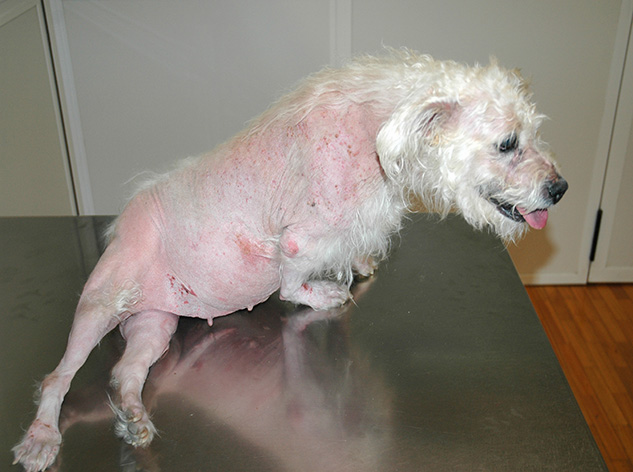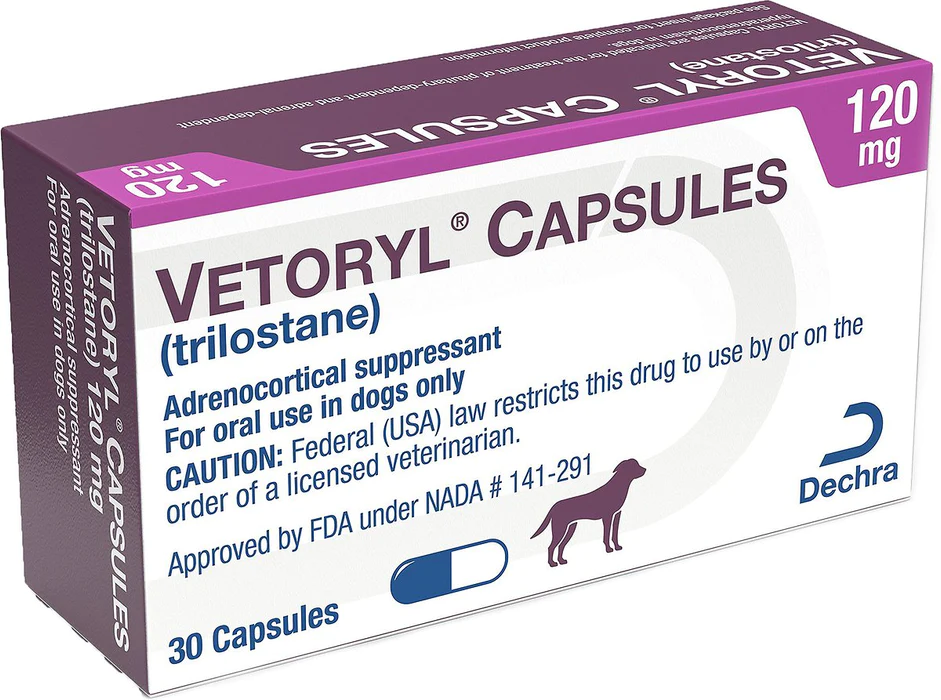Losing a pet for whatever reason is not an easy thing for any dog parent.If the vet prescribed Vetoryl after diagnosing your dog with Cushing disease but the treatment did not have the desired effect as your dog ended up losing his life. It is hard to come to terms with the truth especially if you suspect that the medication played a part in taking your dog’s life. It is necessary to understand what could have contributed to the big loss and what you can do to prevent such cases in days to come.
In this article, you will understand what is Vetoryl, how it works, its alternatives, and much more.
Vetoryl Killed My Dog
Simply because your canine reacted poorly to Vetoryl doesn’t mean that it killed him. If your dog passed away after taking Vetoryl, there may have been underlying medical conditions, drug interactions, an allergic response, or an overdose. Therefore, make sure your veterinarian is aware of your dog’s general health before prescribing a Vetoryl treatment. Additionally, go over any potential Vetoryl adverse effects with your veterinarian.
What Is Vetoryl?
Vetoryl is the only FDA-approved treatment and veterinary-prescribed dog medication used to treat hyperadrenocorticism in dogs (Cushing’s disease) and improve the health and quality of life of diagnosed canines. Vetoryl capsules are once-daily oral tablets that reduce the amount of cortisol that the adrenal glands produce in excess.
Vetoryl consists of the drug trilostane, which reduces the adrenal gland’s excessive production of cortisol, a hormone that regulates several bodily functions and is released in greater quantities during times of stress.
What Is Cushing Disease?
Cushing’s disease causes hormonal issues in canines. This condition is triggered by the overproduction of cortisol, which can be caused by a tumor on the pituitary or adrenal glands.
Cushing’s disease is characterized by a number of symptoms, such as hair loss, obesity, muscle wasting, diarrhea, and vomiting.
Diabetes, congestive heart failure, excessive blood pressure, and liver disease are some of the other severe health issues brought on by this illness.
There are two types of Cushing disease;
Adrenal-mediated– This type of Cushing’s disease is brought on by adrenal-dependent tumors that are located nearby the kidney. This condition is present in 20% of canines with Cushing’s illness.
Pituitary-dependent – The more frequent type is Cushing’s disease which is brought on by a tumor on the pituitary gland. This type is responsible for about 80% of canine cases of Cushing’s disease.
What are the clinical signs of Cushing’s disease in a dog?
The following clinical symptoms may be present in some or all dogs with Cushing’s disease:
- Restlessness, which may include senior dog anxiety at night
- Panting
- Possible behavior changes
- Increased drinking and urinating
- Increased appetite
- Weight gain
- A pot-bellied appearance
- Thinning skin
- Weakness
- Muscle wasting or loss of muscle mass (It’s worth noting that due to the loss of muscle mass, a dog suffering from arthritis may suddenly worsen.)
- Hair loss
- Skin changes—much like that of a teenager!
- Skin infections (called pyoderma)
- Urinary tract infections
How Vetoryl® Works
Vetoryl® is used to treat hyperadrenocorticism by working as an enzyme to reduce the amount of cortisol produced, which is too much in animals with Cushing’s disease. Vetoryl® can control Cushing’s disease and enhance your pet’s quality of life, but it does not treat the condition. Your veterinarian might suggest a compounded version of trilostane depending on the situation. Compounded medications are prescribed when an FDA-approved drug cannot adequately treat your pet’s condition, such as when your pet has trouble swallowing pills in capsule form, when the dosage strength is not widely available, or when the pet is allergic to a component of the FDA-approved drug. The FDA does not approve compounded medicines.
They are tailored specifically to a patient’s requirements by either a licensed veterinarian or a licensed pharmacist. However, dogs with hyperadrenocorticism may not respond as well to some compounded trilostane formulas. Always consult your vet to determine the ideal medication for your pet’s particular needs.
Is Cushing’s Disease Common in Dogs?

In the US, Cushing’s syndrome affects about 100,000 dogs per year. Cushing’s disease can affect dogs of any age, but it is most common in those over the age of six.
Vetoryl® Directions
Observe the instructions on the medication’s label or those that your vet provides. Vetoryl® is usually given once daily, but depending on how well the medicine is working for your pet, your veterinarian might advise giving it twice daily. Vetoryl® must be administered with meals. Vetoryl Capsules cannot be opened or split. Without your veterinarian’s specific instructions, do not cease giving this medication or alter how much you give it.
For the treatment of dog hyperadrenocorticism, the initial daily dosage is one to three milligrams (mg) per pound. There are five strengths available in capsule form: 5 mg, 10 mg, 30 mg, 60 mg, and 120 mg. (each bottle comes with Vetoryl mg 30 ct capsules).
Missed a Dose?
If you forget to administer a Vetoryl® dose, do so as soon as you remember. If your next dose is approaching, skip the missed one and go back to your regular dosing plan. Give no additional or double amounts.
What Are The Precautions Of Which You Should Be Aware?
Your dog should not use Vetoryl capsules if he/she;
- Has kidney and liver diseases.
- Is under specific medicines.
- Is pregnant.
Consumes specific medicines. Several drugs used to treat heart problems (some diuretics and ACE inhibitors) should be used cautiously with VETORYL Capsules.
Inform your vet of all medications you have given your canine in the past as well as any that you intend to give along with VETORYL Capsules. Other prescription-free medications should be included in this.
Avoid handling the capsules if you are pregnant or attempting to get pregnant. Birth defects and early pregnancy loss have been shown by studies in laboratory animals. Take the labeled container with you when seeking medical attention in the event of an unintentional overdose.
The vet might want to confirm that it’s okay to administer your dog’s medications all at once.
Call your physician or the national Poison Control Center hotline at 800-222-1222 if you accidentally consume a pet’s medicine.
Monitoring
It is advised to closely monitor this medication. Ten to fourteen days after administering Vetoryl®, testing is advised to track your pet’s reaction to the medication. There may need to be individual dose changes. Depending on your pet’s specific requirements and any additional medications they may be taking, routine monitoring may then be advised every 1-3 months.
Storage
Trilostane’s storage needs may vary depending on its strength or dosage shape. For information on how to store a prescription you obtain, read the labeling, or speak with your pharmacist.
Vetoryl® Possible Side Effects
During treatment with Vetoryl®, your pet may experience an Addisonian crisis, a potentially fatal disease if their steroid levels drop too low. If your pet exhibits any of the signs listed below, please call your veterinarian immediately. Vomiting
- Lower stamina levels (Lethargy)
- Anorexia
- Weakness
- Diarrhea (especially bloody diarrhea)
- Collapse
What drugs interact with Vetoryl?
Telling your veterinarian about any additional medications you give your canine, including supplements, herbal treatments, and Chinese traditional medicines, is crucial if they have been identified with Cushing’s disease and are receiving treatment for it. Your dog could get significantly worse if you give him any medicine like ketoconazole that inhibits the production of steroids. Trilostane is known to interact with several medications, including:
- Ketoconazole
- Mitotane
- Potassium supplements
- Potassium-sparing diuretics
- Aminoglutethimide
- ACE inhibitors
Can Vetoryl Cause Tremors As a Side Effect?
Tremors are uncontrollable muscular movements that make a dog tremble or shake. Any area of the body can be affected, and they can be mild or severe. When a canine is stressed or excited, tremors may occasionally be noticeable. They might, however, persist constantly and even prevent a dog from being able to drink or eat. Even though tremors are typically not harmful, they can still be unpleasant for your canine and can even get worse. Please call your veterinarian as soon as you observe your dog trembling so they can determine whether Vetoryl is to blame and offer treatment advice.
What To Do If Vetoryl Is Not Working on Dogs?
Don’t give up if your canine is taking Vetoryl but it isn’t helping. You can attempt a few different things to help your dog’s Vetoryl dosage get back on track. Make sure you’re providing the right dosage first. Vetoryl should be administered once daily at a starting dosage of 2.2 to 6.7 mg/kg body weight. Use your dog’s ideal weight as a guide if you’re uncertain of its precise weight. To determine the proper dosage, you can also get assistance from your veterinarian. Your veterinarian might advise increasing the dose or switching to twice-daily dosing if Vetoryl is still not working even after you are providing the recommended dosage.
To ensure that your dog doesn’t suffer any unfavorable effects, these changes should be made with the assistance of a veterinarian. There are still other choices available if after trying these things Vetoryl is still not helping your dog. Your veterinarian can go over these with you and assist you in determining the best course of action for your pet’s care.
Vetoryl® Alternatives
Even though trilostane has been proposed to be the best option for treating hyperadrenocorticism, there are both medical and surgical alternatives;
Mitotane: mitotane destroys the area of the adrenal gland responsible for Cushing’s syndrome. Historically, this was the first treatment to aid a sick dog in overcoming the clinical symptoms, but it also caused an increase in the number of dogs who eventually developed the fatal Addison disease. Dogs treated with mitotane typically survive about as long as those treated with trilostane as long as their adrenal glands do not malfunction.
Ketoconazole: Dogs who have issues with trilostane may also benefit from ketoconazole, a drug typically used as an anti-fungal. Even though fewer dogs are free of clinical signs after a comparable amount of time has passed, it does work well enough for some animals. Additionally, the price is much lower.
Adrenalectomy: This is a surgical process to remove the complete adrenal gland as opposed to just destroying a portion of the adrenal glands. To prevent Addison’s crisis, dogs require lifetime supplemental hormones and mineralocorticoids.
Hypophysectomy: This entails the removal of pituitary gland tumors during this expensive brain surgery. The dog will require several hormone supplements for the remainder of its life if the entire pituitary needs to be removed.
Radiation Therapy: Only certain veterinary schools or cancer-treatment specialties offer this procedure. One study’s findings showed that dogs receiving radiation therapy for pituitary tumors typically only survived for 4 months, though one dog did survive for three years.
Herbal Therapy (ginseng, melatonin, lignan): These options don’t deal with the problem’s underlying causes. Although there are no tests to prove their effectiveness, they might help lower cortisol levels.
FAQs
How do I stop Vetoryl?
Most patients will need Vetoryl for the remainder of their lives once they begin treatment. Therefore, you should continue to administer Vetoryl at the dose and frequency advised by your veterinarian unless otherwise told to do so. If your dog exhibits any symptoms of illness while taking Vetoryl, such as lethargy, vomiting, diarrhea, or anorexia, then this rule will not apply. When this occurs, cease all treatment right away and call your veterinarian as soon as you can.
How long does it take Vetoryl to work on dogs?
Vetoryl® begins to function after one to two days. However, it might take a few weeks before the medication’s benefits become apparent.
Can Vetoryl cause dehydration in dogs?
Yes, dogs that take Vetoryl may become dehydrated, particularly if they become sick or have diarrhea or vomiting as a side effect. Make sure your canine always has access to plenty of fresh water, and get in touch with your veterinarian if you see any symptoms of dehydration, like lethargy, dry mouth, or sunken eyes.
Can Vetoryl cause changes in behavior in dogs?
Yes, taking Vetoryl may cause behavioral changes in some canines. Increased aggression, sluggishness, or appetite shifts are a few examples. It’s essential to get in touch with your veterinarian right away if you notice any strange changes in your dog’s behavior.
Final Thought
Vetoryl has been used for a long time to treat Cushing disease. This steroid acts by preventing the synthesis of cortisol. As a result, the adrenal glands produce less cortisol, which aids in lessening signs like frequent urination and thirst.
Vetoryl is frequently regarded as a last-resort treatment because, when used improperly, it can have severe side effects. The medication can induce sodium retention, which can lead to high blood pressure and heart failure.
Vetoryl can also lead to diabetes, osteoporosis, weak muscles, and kidney failure. If you have any questions regarding Cushing’s disease treatment strategy for your canine, consult your veterinarian.

